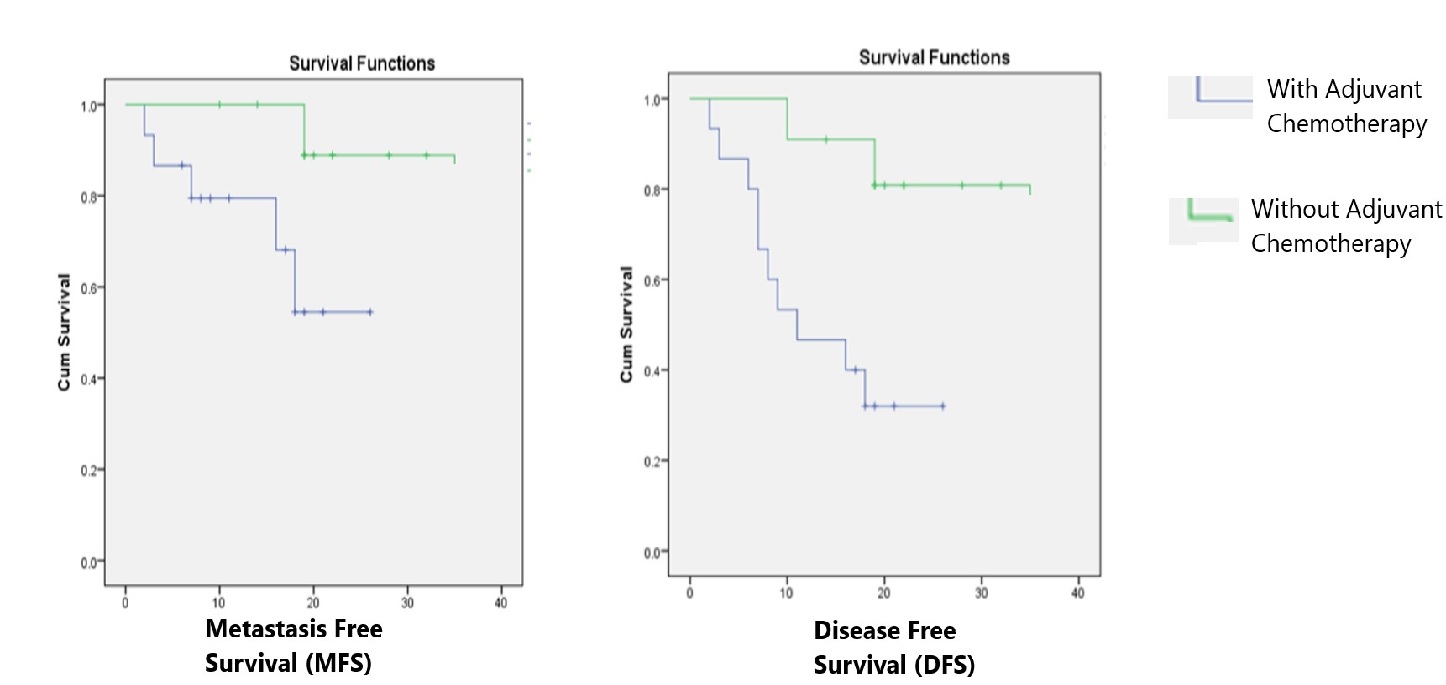Prognostic significance of primary tumour volume in nasopharyngeal carcinoma – a single institute study
Abstract
Introduction: Nasopharyngeal carcinoma is very uncommon in the southern part of India, the age-adjusted incidence rate is less than 1 per 1,00,000 population. This study is undertaken to evaluate the outcome of nasopharyngeal carcinoma and its correlation with Primary tumor volume.
Material and methods: Total of 50 non-metastatic nasopharyngeal carcinoma patients treated with concurrent chemo radiation between January 2013 and December 2015 were included in the study. All patients were treated via IMRT with dose of 66-70Gy, along with concurrent chemotherapy. Initial tumour volume was measured from CT based contouring and mean dose delivered was calculated. All patients were followed up for survival, relapse and metastasis.
Results: The median follow up for the group was 24 months. The median Gross tumor volume of primary disease and nodal disease was 61.6 cubic centimetres and 35.4 cubic centimeters respectively. The 2 year Disease free survival and Overall survival for the entire group was 64% and 68% respectively. There was significant difference (p-0.018) between disease free survival of low volume disease group (LVD) which was 78 % as compared to high volume disease (HVD) group 52 % at 24 months, similarly Overall survival was also significantly better (p-0.015) in LVD group as compared to HVD group 80% vs 55% at 24 months. Among the treatment related factors adjuvant chemotherapy significantly improved the outcome in HVD group but no difference was seen in LVD group.
Conclusion: Our patients had large volume primary disease, the OS and DFS was significantly better in LVD patients, adjuvant chemotherapy after concurrent chemoradiotherapy had no additional benefit for LVD patients but improved DFS and MFS in HVD Patients.
Downloads
References
Amal Chandra Kataki, Malcolm J. Simons, Ashok Kumar Das, Kalpana Sharma, and Narinder Kumar Mehra, Nasopharyngeal carcinoma in the North eastern states of India, Chin J Cancer. 2011 Feb; 30(2): 106–113.
Geara FB, Sanguineti G, Tucker SL, et al. Carcinoma of the nasopharynx treated by radiotherapy alone: determinants of distant metastasis and survival. Radiother Oncol. 1997 Apr;43(1):53-61.
Hsu MM, Huang SC, Lynn TC, Hsieh T, et al. The survival of patients with nasopharyngeal carcinoma. Otolaryngol Head Neck Surg. 1982 May-Jun;90(3 Pt 1):289-95.
Shanmugaratnam K, Chan SH, de-Thé G, et al. Histopathology of nasopharyngeal carcinoma: correlations with epidemiology, survival rates and other biological characteristics. Cancer. 1979 Sep;44(3):1029-44.
Jeong-Hyun Kim and Joon-Kyoo Lee., Prognostic Value of Tumor Volume in Nasopharyngeal Carcinoma Yonsei Medical Journal2005; 46: 2; 221 – 227.
Lin JC, Jan JS, Hsu CY, et al. Phase III study of concurrent chemoradiotherapy versus radiotherapy alone for advanced nasopharyngeal carcinoma: positive effect on overall and progression-free survival. J Clin Oncol. 2003 Feb 15;21(4):631-7. DOI: https://doi.org/10.1200/JCO.2003.06.158.
Zheng Wu, Mo-Fa Gu, Rui-Fang Zeng, Yong Su and Shao-Min Huang: Correlation between nasopharyngeal carcinoma tumor volume and the 2002 International Union Against Cancer tumor classification system. Radiation Oncology 2013, 8:87.
Chu et al. Primary Tumor Volume of Nasopharyngeal Carcinoma: Significance for Recurrence and Survival, J Chin Med Assoc 2008;71(9):461–466.
Chua DT, Sham JS, Kwong DL, et al. Volumetric analysis of tumor extent in nasopharyngeal carcinoma and correlation with treatment outcome. Int J Radiat Oncol Biol Phys. 1997 Oct 1;39(3):711-9.
Willner J, Baier K, Pfreundner L, et al. Tumor volume and local control in primary radiotherapy of nasopharyngeal carcinoma. Acta Oncol. 1999;38(8):1025-30.
Sze WM, Lee AW, Yau TK, et al. Primary tumor volume of nasopharyngeal carcinoma: prognostic significance for local control. Int J Radiat Oncol Biol Phys. 2004 May 1;59(1):21-7. DOI: https://doi.org/10.1016/j.ijrobp.2003.10.027.
Chen C, Fei Z, Pan J, Bai P, Chen L: Significance of primary tumor volume and T-stage on prognosis in nasopharyngeal carcinoma treated with intensity-modulated radiation therapy. Jpn J Clin Oncol 2011, 41:537–542.
Sze WM, Lee AW, Yau TK, et al. Primary tumor volume of nasopharyngeal carcinoma: prognostic significance for local control. Int J Radiat Oncol Biol Phys. 2004 May 1;59(1):21-7.
Al-Sarraf M, LeBlanc M, Giri PG, et al. Chemoradiotherapy versus radiotherapy in patients with advanced nasopharyngeal cancer: phase III randomized Intergroup study 0099. J Clin Oncol. 1998 Apr;16(4):1310-7. DOI: https://doi.org/10.1200/JCO.1998.16.4.1310.
Cheng SH, Tsai SY, Yen KL, Prognostic significance of parapharyngeal space venous plexus and marrow involvement: potential landmarks of dissemination for stage I-III nasopharyngeal carcinoma. Int J Radiat Oncol Biol Phys. 2005 Feb 1;61(2):456-65.



 OAI - Open Archives Initiative
OAI - Open Archives Initiative


